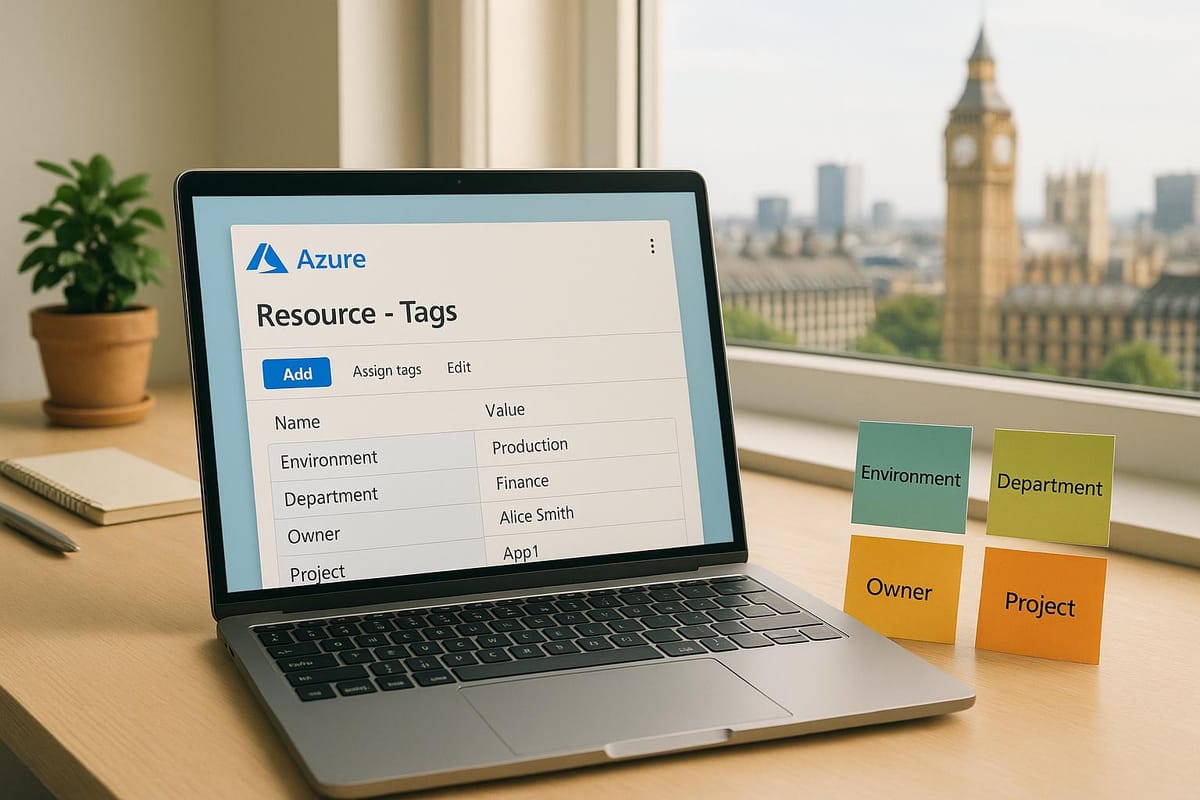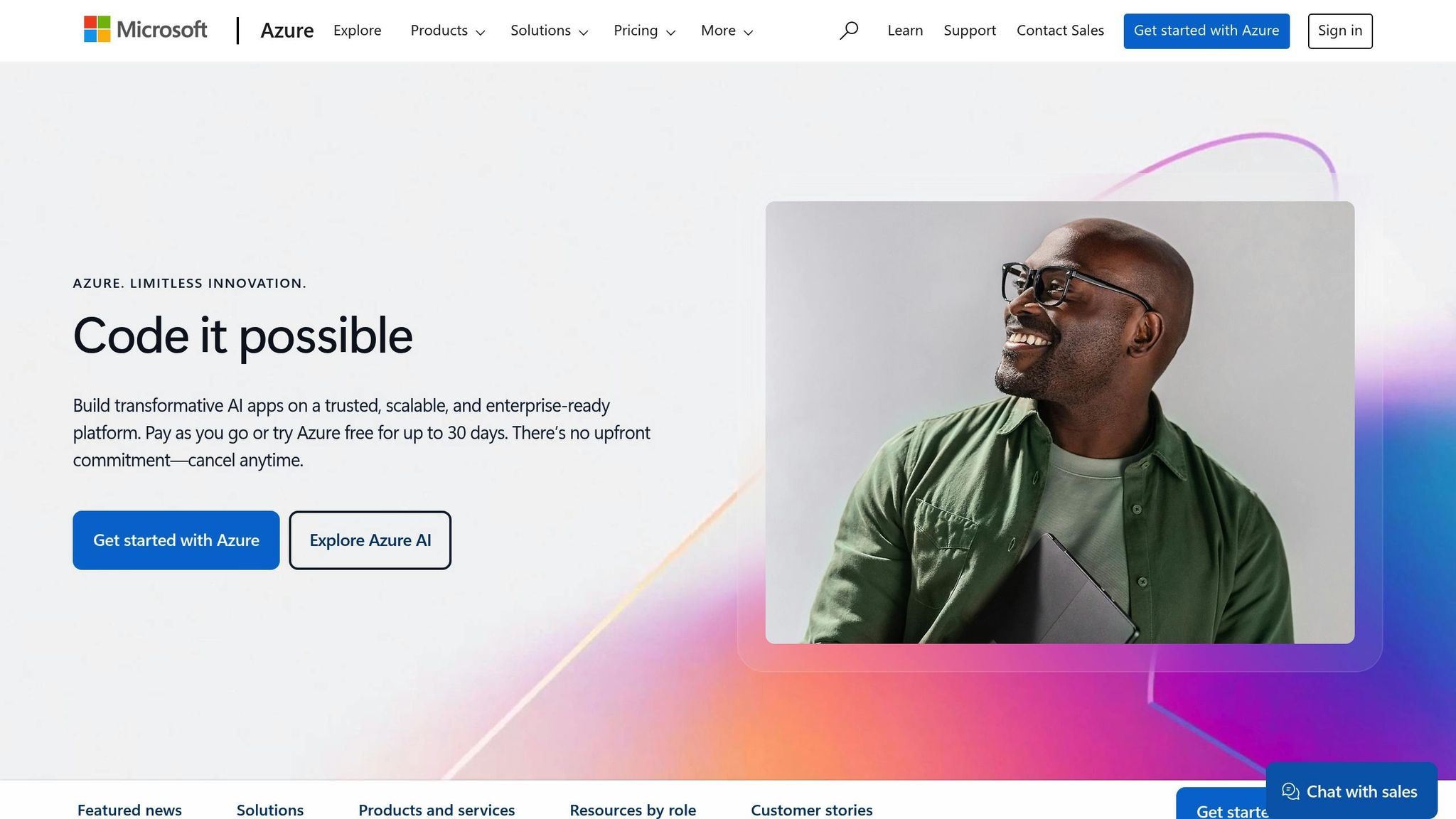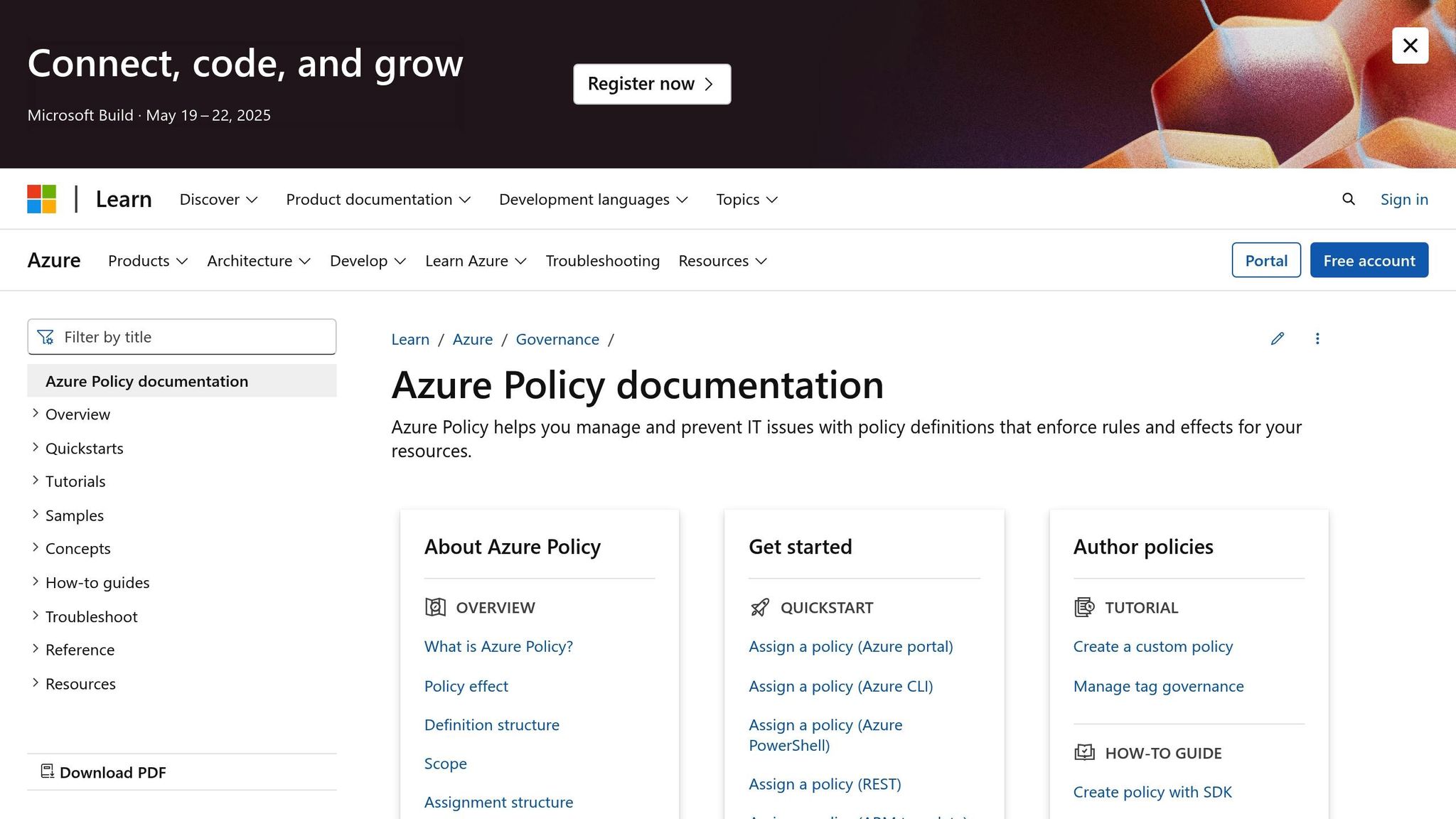Ultimate Guide to Azure Resource Tagging
Learn how effective Azure resource tagging can enhance cost management, compliance, and operational efficiency for UK businesses.

Azure resource tagging is a powerful way to organise and manage your cloud resources. By attaching key-value pairs (e.g., department = finance or environment = production) to your resources, you can:
- Track Costs: Monitor spending by department, project, or environment.
- Enforce Policies: Maintain compliance with UK data protection laws and automate governance.
- Streamline Operations: Simplify resource tracking, prioritisation, and issue resolution.
- Improve Monitoring: Quickly identify critical resources and dependencies.
Key Highlights:
- Tags can be applied to individual resources, groups, or subscriptions.
- Azure supports up to 50 tags per resource.
- Automate tagging with Azure Policy for consistency and efficiency.
- Use UK-specific formats like
£for budgets and DD/MM/YYYY for dates.
Example: Tagging resources with budget = £15,000 and environment = production helps businesses track expenses and manage live systems effectively.
Whether you're a small business or scaling operations, a solid tagging strategy improves cost control, governance, and resource management. Keep reading to learn how to plan, implement, and automate tags for your Azure environment.
Why Azure Resource Tags Are Essential?

SMB Benefits of Azure Tags
Azure tags provide small and medium-sized businesses (SMBs) with practical tools for managing cloud resources. They help with accurate cost tracking, enforcing policies, and resolving issues efficiently.
Cost Tracking and Resource Usage
Tags are essential for keeping cloud spending under control. By assigning specific tags, SMBs can monitor and analyse costs in detail.
Combine Azure Cost Management with tagging to:
- Track departmental spending using tags like
costcentreanddepartment. - Monitor project-specific expenses with tags such as
projectandphase. - Analyse resource usage through tags like
usageandworkload.
For instance, tagging resources with budget = Q2-2025 allows businesses to monitor quarterly expenses with precision.
This level of cost monitoring also supports better governance and policy implementation.
Policy Control and Standards
Tags play a critical role in managing compliance and governance. SMBs can use them to ensure a consistent approach across their Azure environment.
Benefits of tagging for policy control include:
- Enforcing consistent naming conventions.
- Ensuring compliance with UK data protection laws.
- Tracking resource ownership and accountability.
- Automating policy enforcement with Azure Policy.
Using Azure Policy, businesses can automate the application of these tags, reducing manual intervention and maintaining consistency across resources.
Resource Monitoring and Issue Resolution
Tags simplify troubleshooting by providing clear context about resource relationships and priorities. This helps teams address issues faster and more effectively.
Advantages of tagging for monitoring include:
- Easier identification of resource dependencies.
- Better visibility of operational priorities.
- Faster incident response processes.
- Improved performance tracking.
For example, tagging resources with businessimpact = critical helps teams focus on essential operations, while environment = production clarifies which resources are live during incidents.
By combining well-organised tags with Azure’s monitoring tools, SMBs can:
- Pinpoint performance issues more effectively.
- Understand resource usage patterns.
- Keep systems running efficiently.
- Shorten the time taken to resolve problems.
Creating an SMB Tag Plan
A well-thought-out tagging plan can improve Azure's efficiency and make scaling smoother. Building on earlier points, here's how to define your tagging strategy.
Tag Setup Guidelines
Start by focusing on basic tags that meet both IT and business needs. Here's a framework to guide your tagging system:
| Tag Category | Example Tags | Purpose |
|---|---|---|
| Essential Tags | env = prod, costcentre = finance |
Identifying resources |
| Operational Tags | tier = web, sla = 24hours |
Managing technical operations |
| Business Tags | department = sales, project = q2-2025 |
Tracking costs and ownership |
| Compliance Tags | dataclass = private, retention = 36months |
Meeting regulations |
Stick to these key principles:
- Use consistent formatting, such as camelCase.
- Keep tag names short but meaningful.
- Limit values to only what's necessary.
- Use UK-specific formats, like DD/MM/YYYY for dates.
Common Tag Mistakes to Avoid
To maintain consistency, steer clear of these issues:
Inconsistent Naming
Avoid mixing formats like Environment, environment, and env. Stick to a single format, such as env, for clarity.
Unstructured Values
Instead of allowing free-form text, define specific values. For example, limit environment tags to dev, staging, and prod.
Lack of Cost Tracking
Always include tags for cost allocation, like costcentre or department, to ensure accurate financial reporting.
SMB Tag Examples
Below is an example of a tagging structure tailored for UK-based SMBs using Azure:
Resource Management Tags
businessunit = retail
env = prod
region = uksouth
tier = web
Financial Management Tags
costcentre = it-ops
budget = £25000
quarter = q2-2025
department = operations
Operational Tags
criticality = high
sla = 99.9
backup = daily
maintwindow = sun-0200
Use Azure Policy to apply these tags consistently across your resources. Regular audits will help keep your tags accurate and aligned with changing business needs.
For better efficiency, automate the tagging process with Azure Resource Manager templates and document your standards thoroughly. This ensures consistency across teams while supporting cost control and governance.
Setting Up Azure Tags
Once you've outlined your tagging plan, it's time to put it into action. Here's how you can manage and apply tags effectively in Azure.
Adding Tags in Azure
Azure provides multiple ways to manage tags, making it easier to organise your resources.
Using the Azure Portal
Go to your resource in the Azure Portal and select "Tags" from the left-hand menu. Enter your key–value pairs (e.g., CostCentre: Finance) and click "Save" to apply the tags.
Using Azure CLI
For those who prefer command-line tools, Azure CLI offers a straightforward way to manage tags:
# Add tags to a resource
az resource tag --resource-id <ResourceId> --tags Environment=Production CostCentre=IT-Ops
# Update existing tags
az tag update --resource-id $resource --operation Merge --tags Department=Finance Status=Active
Both methods ensure your tags are applied correctly, so you can choose based on your workflow preferences.
Automating Tags with Azure Policy

Azure Policy simplifies tag management by automating the process. This approach not only saves time but also ensures consistency across your resources.
"Tags are a crucial part of organizing your Azure resources into a taxonomy. When following best practices for tag management, tags can be the basis for applying your business policies with Azure Policy or tracking costs with Cost Management." - Microsoft Learn
For example, Contoso Corp, a UK-based SMB, used automated tagging to cut Azure expenses by 15% in just one quarter.
Manual vs Automated Tagging
To decide between manual and automated tagging, consider the following comparison:
| Aspect | Manual Tagging | Automated Tagging |
|---|---|---|
| Time Investment | High – requires individual attention | Low – set once, applies automatically |
| Error Risk | Higher chance of inconsistencies | Minimal – standardised application |
| Flexibility | Better for unique cases | Limited to predefined rules |
| Maintenance | Requires ongoing manual updates | Automatically enforced and updated |
| Best Suited For | Small environments (fewer than 10 resources) | Large-scale deployments |
For most UK-based small and medium businesses, a hybrid approach works well. Use Azure Policy to enforce standard tags (e.g., Environment, CostCentre) while manually adding specific tags when needed.
To make automated tagging work for you:
- Define base policies that enforce essential tags and allow inheritance from resource groups.
- Use remediation tasks to update tags on existing resources automatically.
This combination ensures your tagging strategy is efficient and tailored to your needs.
UK SMB Tag Examples
Basic Tag Types
When setting up Azure tags for SMBs in the UK, it's important to use standard formats that align with local business norms. Below are key tag categories commonly used by UK organisations:
| Tag Category | Key | Example Values | Purpose |
|---|---|---|---|
| Financial | CostCentre |
UK-FIN-001, UK-MKT-003 |
Tracks budgets using department-specific codes |
| Compliance | DataClassification |
GDPR-Personal, Public |
Ensures adherence to UK/EU data protection regulations |
| Business | Department |
Finance, HR |
Reflects internal organisational departments |
| Technical | Environment |
Dev, UAT, Prod |
Identifies development and operational stages |
| Regional | UKRegion |
London, Manchester |
Specifies geographic locations within the UK |
These categories form the foundation for practical tagging examples outlined below.
Tag Usage Examples
Here are some practical examples of how UK SMBs can implement these tags:
Budget Tracking Tags
{
"CostCentre": "UK-FIN-2025",
"BudgetOwner": "Sarah.Williams",
"QuarterlyBudget": "£15,000"
}
Environment Management Tags
{
"Environment": "Production",
"SupportTeam": "UK-CloudOps",
"BusinessHours": "0900-1730GMT"
}
UK-Specific Tag Standards
To maintain consistency and compliance, follow these UK-specific standards:
Currency Formatting
- Use
GBPor the£symbol. - Include pence in decimal format where needed (e.g.,
£1,234.50). - Separate thousands with commas (e.g.,
£1,000,000).
Date Formatting
Dates should follow the UK format (DD/MM/YYYY):
{
"StartDate": "02/05/2025",
"ReviewDate": "30/06/2025",
"MaintenanceWindow": "Wed 20:00-23:00BST"
}
These formats ensure tags are consistent with UK conventions and meet compliance requirements.
Automating Tagging Standards
To simplify and enforce tagging rules, consider automation strategies:
| Tag Enforcement | Implementation Method | Advantage |
|---|---|---|
| Azure Policy | Automated tag inheritance | Maintains uniformity across resources |
| Naming Convention | Use of standard prefixes like UK- |
Facilitates quick identification of UK-specific resources |
| Cost Tracking | Department code format (XXX-###) | Eases financial reporting and tracking |
Conclusion
Building on the strategies outlined earlier, this section pulls together the key aspects of effective Azure resource tagging.
Main Points
Tagging Azure resources effectively can greatly improve resource management for UK organisations. By implementing tags thoughtfully, SMBs can:
- Assign accurate cost codes to maintain better budget oversight
- Meet compliance requirements through clear data classification
- Simplify resource management across various environments and regions
- Use automation to maintain consistent governance through tag enforcement
A well-organised tagging system ensures better efficiency, cost tracking, and governance.
Getting Started
1. Review Current Setup
Start by auditing your existing resources to pinpoint gaps in naming conventions and organisation. Identify the tags that will best align with both IT and business needs.
2. Develop Your Tag Plan
Create a structured tagging approach based on these components:
| Component | How to Implement | Benefits |
|---|---|---|
| Basic Tags | Use workload name, data classification, and criticality | Allows quick identification of resources |
| Cost Tags | Add cost centre, department, and budget codes | Improves financial tracking |
| Operational Tags | Include environment, region, and support team details | Simplifies resource management |
For UK-specific formatting, use DD/MM/YYYY for dates and the '£' symbol for budgets.
3. Implement Automation
Use Azure Policy to enforce tagging standards. This ensures:
- Uniform application of tags and automated inheritance
- Regular compliance checks and reporting for better governance
FAQs
How can small and medium-sized businesses create an effective tagging strategy in Azure to better manage costs and resources?
To manage costs and resources effectively, SMBs should establish a clear and consistent tagging strategy in Azure. Start by defining tags that capture key details such as ownership, workload, environment (e.g., production or testing), and cost centre. These tags help organise and categorise resources for better visibility and control.
Use Azure Policy to enforce tagging rules and ensure all resources are consistently tagged. This can prevent untagged resources from being created and apply required tags automatically. Additionally, group resources using tags to track costs by department, project, or business unit, making it easier to analyse spending and optimise budgets. For further efficiency, consider automating the tagging process using scripts or tools to save time and reduce errors.
How can I automate Azure resource tagging to maintain consistency and compliance across all resources?
To ensure consistent and compliant tagging in Azure, start by creating a clear tagging strategy. Define standardised naming conventions and decide on key tags, such as owner, environment, cost centre, and project. This helps maintain uniformity and ensures all resources are easily identifiable.
Use automation tools like Azure Policy and PowerShell scripts to apply and manage tags efficiently. Azure Policy can enforce tagging rules, automatically adding or updating tags during resource deployment. This minimises manual errors and ensures compliance across your environment.
Finally, leverage tags for better cost management and governance. For example, tags can help allocate expenses to specific departments or projects and identify high-cost resources for optimisation. Consistent tagging also supports security by enabling policies to be applied to sensitive resources based on tags.
How can Azure resource tagging help organisations comply with UK data protection laws and governance standards?
Azure resource tagging plays a crucial role in helping organisations comply with UK data protection laws and governance standards. By assigning meaningful tags to resources, businesses can effectively organise and manage their cloud environment, ensuring better oversight and accountability.
Tagging allows for clear identification of resources, making it easier to track costs, enforce compliance policies, and identify any deviations from governance standards. It also supports improved reporting and auditing, which are essential for meeting legal and regulatory requirements in the UK. Additionally, resource tagging can streamline cost management and ensure that resources are being used efficiently, aligning with governance best practices.




